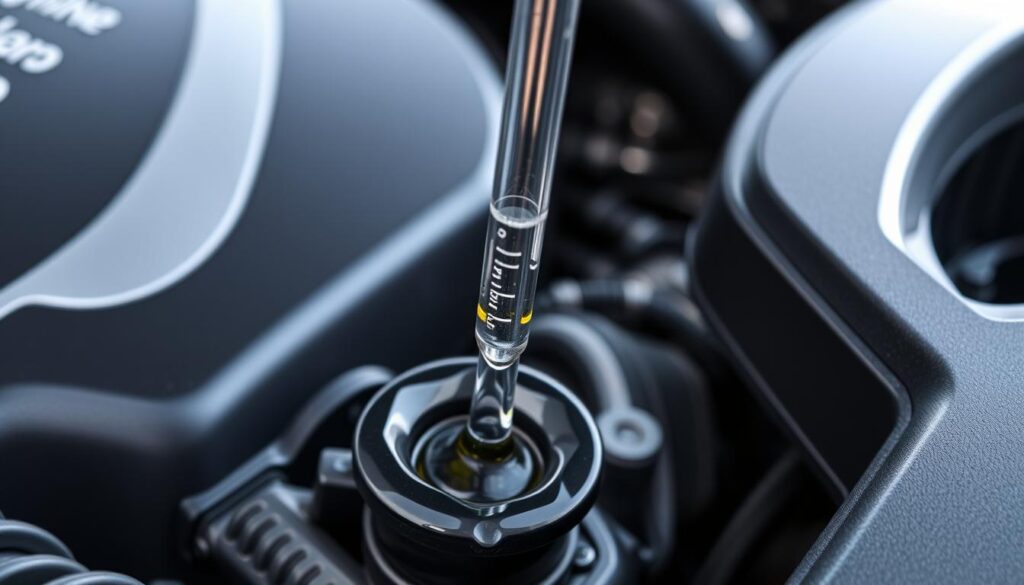We’ve all been there—sitting in your car after a long drive, the engine humming quietly. You start to wonder: when did I last check the oil? Our cars are like a part of us but need a minute to ‘catch their breath’ after running.
Letting the engine cool is crucial. It’s not just a minor detail; it’s essential for your car’s smooth operation. This cooling period makes a big difference. It affects the accuracy of your oil reading. Keep reading to find out why waiting a bit before checking your oil is vital for your car’s well-being.
Key Takeaways
- Wait 10 to 15 minutes for proper engine cool-down before checking oil.
- Accurate oil readings require careful consideration of engine temperature.
- Checking oil once a month helps maintain optimal engine performance.
- Use smartphone apps to keep track of your car’s oil maintenance schedule.
- Visual inspections can indicate if an oil change is necessary.
Understanding the Importance of Engine Oil
Engine oil keeps your vehicle running smoothly and efficiently. It does many things that help your engine work better and last longer. Knowing how engine oil works lets you keep your vehicle in good shape.
What Does Oil Do For Your Engine?
First, engine oil provides engine lubrication for parts like pistons and rocker arms. This reduces friction, preventing overheating and wear. Regular oil changes keep your engine working at its best.
How Oil Protects Engine Components
Oil protection is key for component safety. It creates a barrier that absorbs heat, keeps the right thickness, and ensures smooth running. This stops parts from getting damaged by too much heat. Good engine lubrication prevents dirt from harming your engine over time.
Knowing how oil interacts with your engine helps you choose the right oil and service times. This makes your vehicle healthier and more efficient.
| Engine Oil Functions | Benefits | Impact on Engine |
|---|---|---|
| Reduces Friction | Increases efficiency | Prevents overheating |
| Absorbs Heat | Promotes smoother operation | Protects against wear |
| Cleans Engine Parts | Prevents contamination | Enhances engine longevity |
| Acts as a Sealant | Minimizes leaks | Improves component safety |
Why Cool-Down Time Matters
Knowing why it’s important to let your engine cool is key for correct oil checks. The heat from the engine changes how thick the oil is. When the engine is hot, the oil gets thinner. This can make the oil level look different than it really is. Touching hot oil is also dangerous. So, it’s important to wait before checking the oil.
Effects of Heat on Engine Oil
Heat affects the thickness of engine oil. When the oil heats up, it becomes thinner and expands. This can make your oil level look off if you measure while it’s still hot. Experts recommend waiting 10-15 minutes after shutting off the engine. This wait gives the oil time to cool down and show the right level.
Safety Precautions When Checking Oil
It’s important to be safe when checking your oil. Hot oil can burn you. By waiting a bit after turning off the engine, you lower the risk of getting hurt. It helps to wear gloves and wait until the oil has cooled. This makes checking your oil levels safer.

How Long To Let Engine Cool Before Checking Oil?
It’s important to know how long to wait before checking your engine oil. This ensures you get an accurate reading. Most experts suggest waiting for 10 to 15 minutes after turning off the engine. This short wait lets the engine cool and the oil settle back to its normal level.
Recommended Cool-Down Duration
Hot oil can make it tricky to get a good reading. By letting the engine cool, you avoid the chance of getting burned. More importantly, it allows the oil to cool down too. Then, you can check the oil on the dipstick without getting misleading results.
False Readings from Hot Oil
Checking the oil right after driving can give you the wrong idea about your oil level. That’s because hot oil expands and might look like there’s more than there is. Giving your car some time to cool helps you avoid thinking you have enough oil when you might not.

| Duration | Effect |
|---|---|
| Immediate check | High risk of inaccurate oil levels due to hot oil effects |
| 10-15 minutes | Stabilizes oil temperature, allows for accurate measurement |
| Over 15 minutes | Oil fully settles, providing a clear and precise reading |
Taking a bit of time to let your engine cool makes a big difference. This easy step can make your oil checks much more reliable. It helps keep your vehicle running smoothly for a long time.
Steps to Check Your Oil Level Accurately
It’s crucial to keep your engine oil at the right level for your car to run well. A good method ensures you get the correct oil measurement. Start by making sure your car is on even ground. This avoids incorrect readings:
Check on a Level Surface
First, make sure to park your vehicle on a flat surface. This prevents any false readings. Even a small slope can cause the oil to pool unevenly, giving you a wrong measure. A flat spot ensures your oil level reading is spot-on.
Proper Cool-Down and Preparation
After parking, give your engine some time to cool, about 10 to 15 minutes. This lets the oil settle back down for an accurate reading. During this cooldown, get your oil check tools ready, like a clean cloth for the dipstick.
Now, you’re set to check the oil:
- Take out the dipstick.
- Clean it off with your rag.
- Put the dipstick all the way back in.
- Pull it out again to see the oil level on the marks.
Keeping your tools handy and following these steps ensures a good engine oil check. Doing this regularly prevents future problems and keeps your car running right.

| Action | Notes |
|---|---|
| Check on Level Surface | Prevents inaccurate readings caused by incline |
| Cool Down Engine | 10-15 minutes allows for oil settling |
| Wipe Dipstick | Ensures accurate measurement for the next reading |
| Reinsert Dipstick | Helps gather an accurate oil level reading |
When to Add or Change Your Engine Oil
Keeping the right amount of oil in your engine is key for it to work well. You need to check your oil often to keep your vehicle in good shape. Learning to spot when the oil is low and what to do about it is crucial. This knowledge helps you avoid engine damage and expensive fixes. Knowing when to top up or swap out your engine oil is a big boost to your engine care routine.
Identifying Low Oil Levels
Recognizing low oil levels is vital for oil upkeep. It’s best to check your oil regularly, around every few hundred miles. Watch out for these signs:
- Dashboard oil change indicators that signal low oil levels.
- Strange engine noises, like knocking or grinding, hinting at low oil.
- An engine that doesn’t run as well as it should.
Let the engine cool for about 10 to 15 minutes before checking for a true oil level. Staying on top of your oil level helps keep your engine at peak performance.
Signs Indicating Oil Change is Due
While monitoring your oil, look for signs that it’s time for an oil change:
- Oil that stays dirty or looks like sludge.
- Going 5,000-7,000 miles since the last oil change, which is typical for most vehicles.
- Colder weather that makes the oil thick, affecting how well it lubricates.
Always follow your vehicle’s manual for the right oil type and weight. Using the wrong oil can reduce protection against engine wear, especially in parts like pistons and rocker arms. Routine oil care keeps your engine running well, avoiding problems that shorten its life. Additionally, mixing different oil weights is generally not recommended as it can affect the oil’s overall performance and ability to protect your engine. The viscosity of the oil is crucial for maintaining proper lubrication, and combining different weights could lead to improper flow or breakdown under high temperatures. To ensure the best protection and longevity for your engine, always stick to the recommended oil type and weight specified in your vehicle’s manual.

| Indicator | Possible Issue | Action Required |
|---|---|---|
| Oil Change Indicator Light | Low oil level | Add oil or schedule a change |
| Unusual Engine Noises | Insufficient lubrication | Check oil level |
| Dirty Oil | Potential engine damage | Change oil |
| Oil Thinning in Cold Weather | Compromised lubrication | Change to a thicker oil if required |
By paying attention to these signs and keeping up with oil checks, you can take good care of your engine’s oil. This helps your engine last longer.
Conclusion
Checking your engine oil is crucial for keeping your car running well. It’s important to let your engine cool before you check the oil. This helps you get the right reading and make good choices about oil changes.
It’s wise to check your oil often, as it’s key to engine care. Try to do it every time you fill up your gas, or at least every other time. This keeps your engine in great shape. Also, changing your oil every 3,000 to 5,000 miles prevents engine damage, which could cost up to $3,000.
Adding these steps to your car care routine improves your engine and saves on gas. By keeping up with oil changes and quality, you protect your car from future problems. Make checking your oil a regular task to keep your engine happy!









